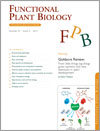
Functional Plant Biology
Volume 44 Number 4 2017
FP16405From little things big things grow: karrikins and new directions in plant development
By sensing changes in the local environment, plants adapt their growth patterns to maximise reproductive success. This review summarises our understanding of how plants detect chemical compounds released into the soil during fire events. This field of research has led to the discovery of an evolutionarily conserved signalling system that has implications for agriculturally relevant aspects of plant development.
FP16266Active defence by an Australian native host, Lomandra longifolia, provides resistance against Phytophthora cinnamomi
The plant pathogen Phytophthora cinnamomi poses a major threat to a wide range of host plants. This study examined resistance in Lomandra longifolia (an Australian native plant) and found high levels of resistance to infection, along with the identification of several resistant-related components. Understanding L. longifolia’s resistance to the pathogen may help develop strategies for protection of more susceptible species.
FP16272Evaluation of root porosity and radial oxygen loss of disomic addition lines of Hordeum marinum in wheat
Hordeum marinum is a waterlogging-tolerant wild relative of wheat (Triticum aestivum) and has been hybridised with wheat to produce amphiploids containing the genomes from both species. We found that although an amphiploid had improved root aeration traits compared with the wheat parent, the addition lines containing chromosome pairs did not have these traits of greater root porosity or a barrier to radial O2 loss. Thus, these root aeration traits were not expressed in any of the six of the seven possible chromosome addition lines, hampering efforts to use H. marinum as a donor of waterlogging tolerance to wheat.
FP16299Vein density is independent of epidermal cell size in Arabidopsis mutants
It has been proposed that the densities at which veins and stomata are present in leaves are co-ordinated by epidermal cell expansion. However, we found that vein density is not causally linked to epidermal cell size. This suggests that adaptation favours synchronised changes to cell size in different leaf tissues to coordinate vein and stomatal density, and thus, maintain a balance between water supply and transpirational demand.
FP16239Transcriptome profiling of rice seedlings under cold stress
Sub-optimal environmental conditions for crops are called abiotic stress; cold is one of the main stresses for rice. In this study, the RNAseq technique was used to identify genes expressed in response to cold in rice germination. The results indicated that a large number of genes were expressed in the sensitive genotype and few genes in the tolerant genotype. We have identified possible genes that are responsible for cold tolerance in rice plants of the cold tolerant cultivar.
FP16258Nitrate increases ethylene production and aerenchyma formation in roots of lowland rice plants under water stress
It remains unclear how water stress affects ethylene production and aerenchyma formation in rice plant supply with different nitrogen forms. The results showed that nitrate nutrition increased ethylene production and aerenchyma formation in roots of lowland rice plants under water stress. We concluded that nitrogen source supply is involved in the regulation of ethylene biosynthesis and function, especially under water stress.
FP16206Defence mechanisms associated with mycorrhiza-induced resistance in wheat against powdery mildew
Little is known about the biocontrol ability of the arbuscular mycorrhizal fungi (AMF) to protect plants against foliar fungal pathogens. We assessed the ability of Funneliformis mosseae to protect wheat against powdery mildew caused by Blumeria graminis f.sp. tritici. AMF treatment revealed a systemic resistance of wheat to B. graminis associated with a stimulation of plant defence responses and interpreted as mycorrhiza-induced resistance.
FP16360Malus domestica ADF1 severs actin filaments in growing pollen tubes
In this work we cloned a new gene ADF1 that severs actin filaments in apple pollen tubes. The aim of the work is to give references to understand the function of ADF generally in vitro and in vivo and the main discovery is ADF severs actin filaments. Finally, we fit the original images into the software Photoshop 6.0 for bigger pictures and use software Image J to produce the video clips.
FP16383The inhibition of photosynthesis under water deficit conditions is more severe in flecked than uniform irradiance in rice (Oryza sativa) plants
The effect of water deficit on photosynthesis in fluctuating irradiance is not well understood, although leaves within a canopy experience a highly variable light environment. This study was conducted by investigating steady-state and dynamic photosynthesis of two rice (Oryza sativa L.) cultivars grown under well-watered and water stress conditions. We found that the inhibition of photosynthesis under water deficit condition is more severe in flecked than steady-state irradiance.



